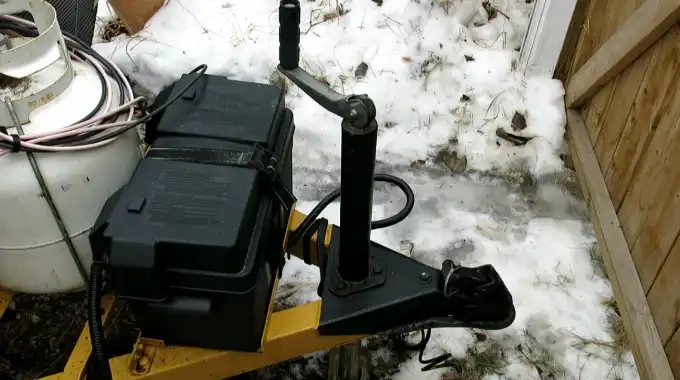Last Updated on April 18, 2023
RV owners must assess several elements to guarantee a safe and comfortable ride, particularly the type of battery they choose. In this regard, venting your batteries is crucial. Otherwise, the hazardous gas buildup could lead to fire hazards and endanger everyone.
Under the wrong conditions, your RV can become a ticking time bomb. Gas buildup without proper ventilation is highly flammable and presents an alarming risk to you and anyone around you. Even worse, inadequate venting could lead to property damage or serious injury.
Therefore, your RV batteries must be vented to prevent such a hazardous situation. To ensure your RV’s safety while traveling, discover why and how to vent your RV batteries to avoid a potentially dangerous situation.
Do RV Batteries Need to be Vented: Reasons Why?
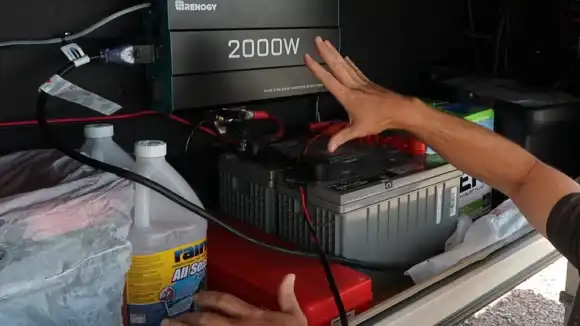
It’s important to remember that RV batteries can produce potentially dangerous gasses as a byproduct of their operation. For this reason, venting RV batteries is crucial for safety. Here is why you must vent your RV batteries:
Preventing Gas Buildup
RV batteries need to be vented for safety reasons. One of the primary reasons is to prevent gas buildup.
When these types of batteries are charged, they produce hydrogen gas which can accumulate in the battery compartment if not properly vented. This buildup can be dangerous as it increases the risk of an explosion.
To prevent gas buildup, you must ensure proper ventilation in the battery compartment. This can be achieved by installing a dedicated battery box ventilation system or ensuring adequate airflow in the case.
Avoiding Fire Hazards
RV batteries also pose a potential fire hazard if not properly vented. The buildup of hydrogen gas during the charging process can be dangerous and even explosive in certain conditions.
Ensuring that your RV batteries are adequately vented is crucial to avoid these risks. This means allowing for proper airflow in the RV battery chamber and installing a dedicated ventilation system if necessary.
Types of RV Batteries that Need Venting
Different types of RV batteries are available in the market, but not all require venting. Here are some types of RV batteries that need to vent:
Flooded Lead-Acid Batteries
Flooded lead-acid batteries are popular for RV owners due to their affordability and reliability. But, they require proper ventilation to ensure safe operation.
These batteries contain a mixture of sulfuric acid and water, which can produce hydrogen gas during the charging process. This gas can accumulate in the battery compartment without proper ventilation, creating a potentially dangerous situation.
Absorbed Glass Mat (AGM) Batteries
AGM batteries are sealed lead-acid batteries that do not require venting. Instead of liquid electrolytes, they use a fiberglass mat soaked in the electrolyte, sandwiched between the battery’s plates. This design makes AGM batteries leak-proof and spill-proof, which is why they are often used in RVs and other vehicles.
One advantage of AGM batteries over flooded lead-acid batteries is that they do not require high maintenance. They do not need to be topped off with distilled water, and there is no risk of acid spills or leaks.
AGM batteries also tend to have a longer lifespan than flooded batteries, making them popular among RV owners. However, it’s important to note that AGM batteries do not emit gas like flooded batteries; they can still generate heat during charging and discharging.
Types of Ventilation Systems for RV Batteries
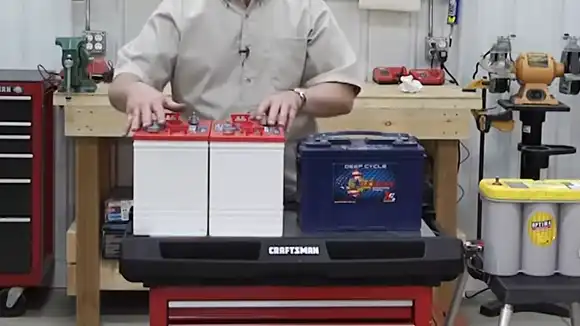
Two types of ventilation systems can be used to prevent dangerous situations: natural ventilation and forced air ventilation.
Natural Ventilation
Natural ventilation is a simple and effective way to keep your RV batteries safe. This ventilation system uses natural airflow to remove harmful gasses that may accumulate during battery charging or use. It is important to note that natural ventilation works best in open spaces with good air circulation.
To achieve proper natural ventilation, you can install vents on the roof or walls of your RV. These vents allow fresh air to enter and hot air to escape, creating a continuous airflow throughout the RV. The size and number of vents required depend on your battery bank size and type.
One advantage of natural ventilation is that it does not require additional equipment or power sources, making it a cost-effective option for RV owners.
Forced Air Ventilation
Forced air ventilation is a ventilation system that uses a fan to circulate air in and out of the RV battery compartment. This method effectively removes harmful gasses from battery compartment, such as hydrogen and sulfuric acid.
One of the main benefits of forced air ventilation is its ability to provide constant airflow, even when the RV is stationary. This ensures that fresh air is always entering the battery compartment, which helps prevent the buildup of dangerous gasses.
Also, forced air ventilation can help regulate temperature and humidity levels inside the battery compartment, extending your RV batteries’ life.
How to Vent RV Batteries Safely?
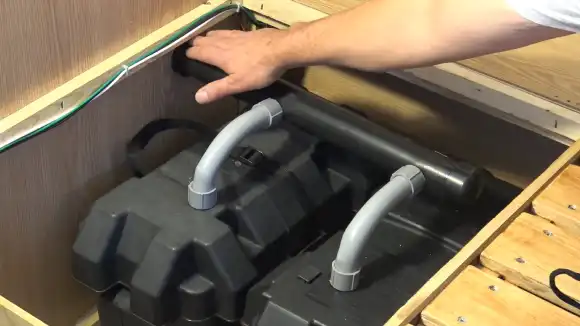
Proper ventilation is essential to ensure your RV batteries’ safe operation. Venting helps to prevent the buildup of explosive gasses that can be released during the charging or discharging of the battery.
Here are some tips on how to vent RV batteries safely:
#1 Ensure Proper Airflow in the Battery Compartment
To ensure proper airflow in your RV battery compartment, keeping the area around the batteries clear of any obstructions is essential. This includes removing any storage items or debris blocking air vents or restricting airflow.
Also, you should ensure enough space around each battery for proper ventilation. If your RV has a dedicated battery compartment, ensure it’s large enough to accommodate all your batteries comfortably. Consult your owner’s manual or speak with an RV technician if you need more space.
#2 Install a Dedicated Battery Box Ventilation System
Installing a dedicated battery box ventilation system is one of the best ways to ensure your RV batteries are properly vented. This type of system is specifically designed to provide proper airflow and prevent gas buildup, which can be especially important for flooded lead-acid batteries.
A dedicated battery box ventilation system typically consists of a small fan mounted on the side or top of the battery compartment. The fan helps to circulate air through the chamber, which can help to prevent gas buildup and reduce the risk of fire hazards.
When installing a dedicated battery box ventilation system, it’s important to ensure that you follow all manufacturer instructions and safety guidelines. This may include using specific wiring or connectors and ensuring the fan is properly grounded.
Best Practices for Installing Ventilation System in Your RV
Installing a proper ventilation system in your RV is crucial to ensure the safety of your batteries and the passengers. Here are some best practices to follow when installing a ventilation system in your RV:
Placement of the Ventilation System
Correct placement of the ventilation system is crucial for ensuring the safety of RV battery use. The proper location for the ventilation is near the RV battery compartment, where it can draw out any harmful gasses that may be generated during charging or discharging.
When installing the ventilation system, the system should be securely mounted and sealed to prevent gas leaks. Ensuring enough space around the ventilation system for adequate airflow is also essential.
Adequate Air Circulation
Without proper ventilation, the battery can release harmful gasses such as hydrogen and sulfuric acid, which can be dangerous to your health and even cause an explosion.
Installing the ventilation system in the right place is essential to ensure adequate air circulation. The ideal location for the ventilation system is near the battery compartment. This will allow for easy installation and efficient removal of any accumulated gasses.
Maintenance and Inspection
Proper maintenance and inspection of your RV batteries are crucial for ensuring their longevity and safety. Neglecting to do so can damage your RV, harm to yourself or others, and even cause fires or explosions.
One important aspect of battery maintenance is checking for any signs of damage or wear. This includes inspecting the terminals and cables for corrosion, cracks, or other issues that could affect the battery’s performance.
It’s also important to regularly check the water levels in flooded lead-acid batteries and add distilled water as needed.
How Much Ventilation Does A Battery Need?
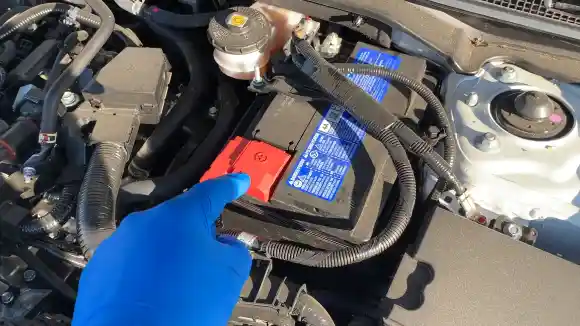
The recommended maximum concentration of hydrogen in a room with flooded lead acid batteries is 1% of the total volume. This level ensures that the risk of explosion or fire is minimized.
Also, it’s important to note that the ventilation system must be designed to cater to the specific requirements of the battery. Failure to adhere to these ventilation guidelines can have serious consequences.
Does a deep-cycle battery need ventilation?
A deep-cycle battery requires ventilation to prevent the buildup of gasses during charging. When charging, a deep-cycle battery releases hydrogen gas which can accumulate in the room and threaten safety.
Proper ventilation helps prevent the buildup of these gasses. It ensures the safety of the battery and the surrounding environment. Remember that the ventilation system should be designed to cater to the battery’s specific requirements.
Fire Hazards Beware: Properly Vent Your RV Batteries
RV batteries do need to be vented for various reasons. Gas buildup can occur in certain types of batteries like flooded lead-acid and AGM batteries, which can pose a fire hazard if not properly vented.
Ensuring proper airflow in the battery compartment and installing a dedicated RV battery box ventilation system can help prevent these dangers. Also, regular inspection and cleaning of the battery compartment and checking fluid levels frequently can help with proper maintenance.
By taking these steps, RV owners can enjoy their travels with peace of mind knowing that their batteries are safe and well-maintained. So, make sure to prioritize battery ventilation and maintenance for a worry-free adventure on the road.
